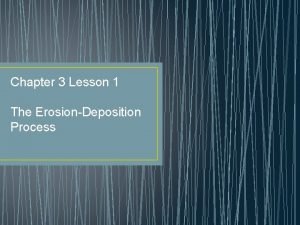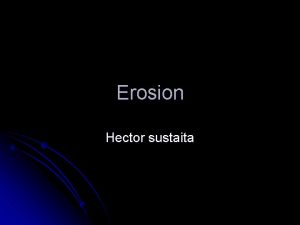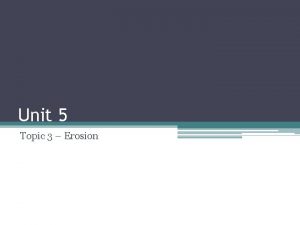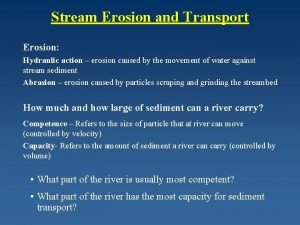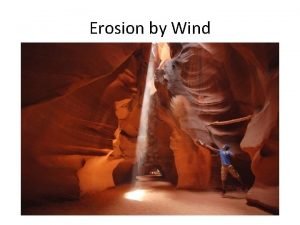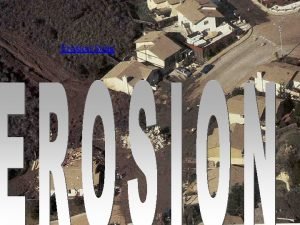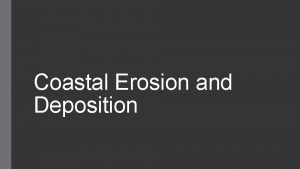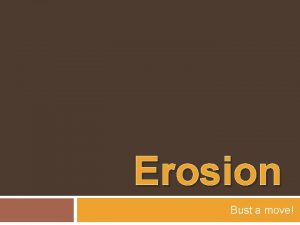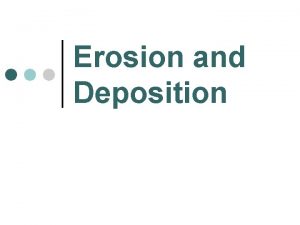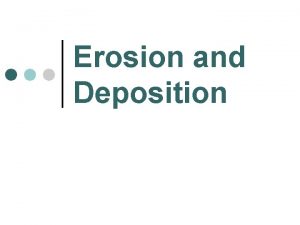Erosion 12715 Definition n Erosion the process of
















- Slides: 16

Erosion 12/7/15

Definition n Erosion- the process of moving sediment from one location to another. n n n Happens after particles are weathered The most important FORCE of erosion is GRAVITY. The most important AGENT of erosion is WATER.

Agents of Erosion n Waves- beach erosion n Wind n Gravity n Ice/glaciers n Water (running)

Phschool. com Cfp 2031 Gravity- Mass Movement n n n Gravity by itself can transport sediments. Sharp-edged unsorted no limit in size often causes “mass wasting” such as landslides

Wind Erosion n n When a current of wind picks up and carries sediments are rounded and have a frosty appearance sorting occurs. particles are small

WIND EROSION SUSPENSION WIN SALTATION D CREEP q SALTATION, particles bounce which loosens particles q SMALLER PARTICLES SUSPENDED q LARGER PARTICLES CREEP (slide/roll)

Conditions necessary for wind erosion: n n n Dry areas Loose sand, silts and clay Little or no vegetation n Deserts, semi-arid areas, ocean coastlines

1. 2. 3. Which areas of the United States experience wind erosion? Where is the largest area of wind erosion? Second largest? What coastal areas are subject to wind erosion? Why?

Wind erosion- forms sand dunes

Waves- beach erosion n Particles are sorted and rounded n Erosion occurs due to waves, winds, tides storms, earthquakes, construction and relative sea level rise

How do waves approach the shore? n n n Most waves move at an angle. Swash- waves moving towards the shore– depositing large amounts of sand. Backwash Waves moving away- pull sand back.


Long shore Currents n Waves that move parallel to the shore.


Vocab- Lab- Nature of Sand n n n Weathering- process of breaking rocks/substances down into smaller pieces Erosion- process of transporting smaller pieces from one place to another Parent Rock- the original rock from which something else was formed Sediments- broken down rock Composition- the minerals that make up the rock/sediment

VOCAB- Rock Abrasion in a Stream n n Abrasion- process of scraping or wearing away- (when rocks hit against each other) Weathering- breaking down of rock into smaller pieces Sediment- naturally occurring material broken down as a result of weathering Soluble- able to be dissolved
 Chad lentz
Chad lentz The erosion-deposition process
The erosion-deposition process Hát kết hợp bộ gõ cơ thể
Hát kết hợp bộ gõ cơ thể Slidetodoc
Slidetodoc Bổ thể
Bổ thể Tỉ lệ cơ thể trẻ em
Tỉ lệ cơ thể trẻ em Voi kéo gỗ như thế nào
Voi kéo gỗ như thế nào Tư thế worm breton là gì
Tư thế worm breton là gì Chúa yêu trần thế alleluia
Chúa yêu trần thế alleluia Các môn thể thao bắt đầu bằng tiếng nhảy
Các môn thể thao bắt đầu bằng tiếng nhảy Thế nào là hệ số cao nhất
Thế nào là hệ số cao nhất Các châu lục và đại dương trên thế giới
Các châu lục và đại dương trên thế giới Công thức tính độ biến thiên đông lượng
Công thức tính độ biến thiên đông lượng Trời xanh đây là của chúng ta thể thơ
Trời xanh đây là của chúng ta thể thơ Mật thư tọa độ 5x5
Mật thư tọa độ 5x5 Làm thế nào để 102-1=99
Làm thế nào để 102-1=99 Phản ứng thế ankan
Phản ứng thế ankan

